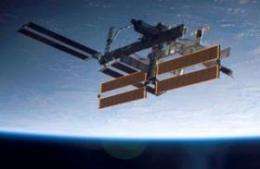NASA Releases Interactive 3-D Views of Space Station, New Mars Rover

(PhysOrg.com) -- NASA released an interactive, 3-D photographic collection of internal and external views of the International Space Station and a model of the next Mars rover on Thursday, May 7.
NASA and Microsoft's Virtual Earth team developed the online experience with hundreds of photographs and Microsoft’s photo imaging technology called Photosynth. Using a click-and-drag interface, viewers can zoom in to see details of the space station's modules and solar arrays or zoom out for a more global view of the complex.
"Photosynth brings the public closer to our spaceflight equipment and hardware," said Bill Gerstenmaier, associate administrator for Space Operations at NASA Headquarters in Washington. "The space station pictures are not simulations or graphic representations but actual images taken recently by astronauts while in orbit. Although you're not flying 220 miles above the Earth at 17,500 miles an hour, it allows you to navigate and view amazing details of the real station as though you were there."
The software uses photographs from standard digital cameras to construct a 3-D view that can be navigated and explored online.
The Mars rover imagery gives viewers an opportunity to preview the hardware of NASA's Mars Science Laboratory, currently being assembled for launch to the Red Planet in 2011.
"We are making this enhanced viewing experience available from the Mars Science Laboratory project because we're eager for the public to share in the excitement that's building for this mission," said Fuk Li, manager of NASA's Mars Exploration Program at NASA's Jet Propulsion Laboratory in Pasadena, Calif.
NASA's Photosynth collection can be viewed at: www.nasa.gov/photosynth .
The NASA images also can be viewed on Microsoft’s Virtual Earth Web site at: www.microsoft.com/virtualearth .
While roaming through different components of the station, the public also can join in a scavenger hunt. NASA has a list of items that can be found in the Photosynth collection. These items include a station crew patch, a spacesuit and a bell that is traditionally used to announce the arrival of a visiting spacecraft. Clues to help in the hunt will be posted on NASA’s Facebook page and @NASA on Twitter. To access these sites, visit: www.nasa.gov/collaborate .
NASA astronaut Sandra Magnus took the internal images of the space station during the 129 days she lived aboard the complex. She photographed the station’s exterior while aboard the space shuttle Discovery, which flew her back to Earth in March. The rover images were taken of a full-scale model in a Mars-simulation testing area at NASA's Jet Propulsion Laboratory in Pasadena, Calif. Photosynth has multiple potential benefits for NASA. Engineers can use it to examine hardware, and astronauts can use it for space station familiarization training.
Photosynth software allows the combination of up to thousands of regular digital photos of a scene to present a detailed 3-D model of a subject, giving viewers the sensation of smoothly gliding around the scene from every angle. A collection can be constructed using photos from a single source or multiple sources. The NASA Photosynth collection also includes shuttle Endeavour preparing for its STS-118 mission in August 2008.















